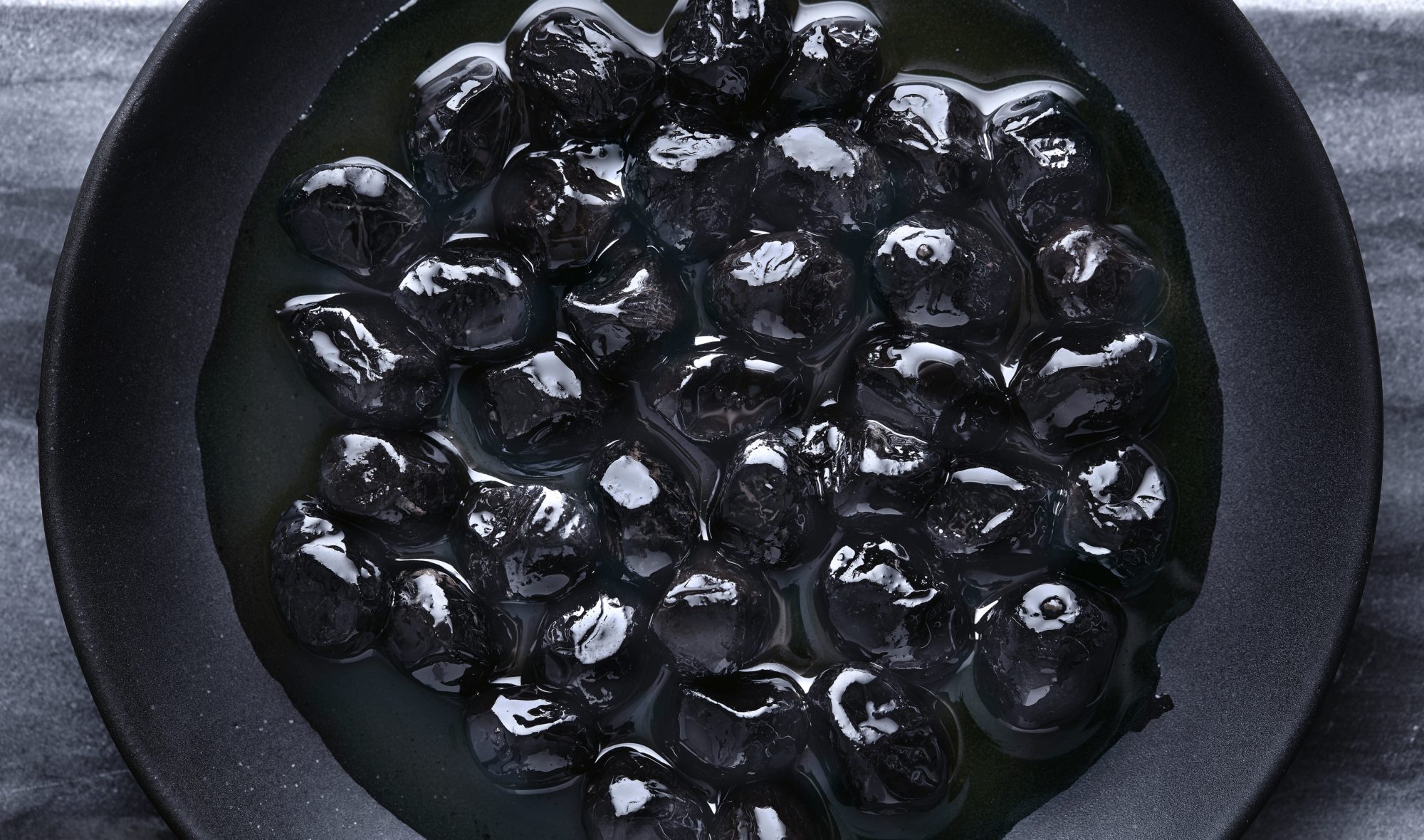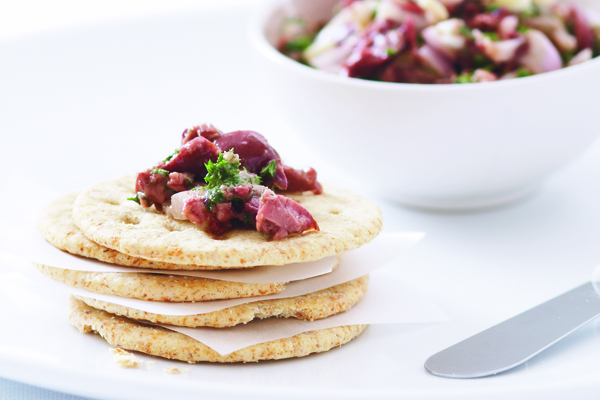Olives


Olives are the fruit from a tree that grows in Mediterranean climates. Too bitter to eat fresh, olives are usually pickled or cured. They are also used to make olive oil. Olives are very high in fat: 10 large canned olives have nearly 5g of fat, but most is in the form of oleic acid, a monounsaturated fatty acid that has proven benefits on cholesterol levels and blood pressure. Olives also contain antioxidants and anti-inflammatory properties, along with fiber, vitamin E, and vitamin A. Olives can be enjoyed as a snack or included in other recipes; add them to pasta sauces, salads, or roasted meat dishes.
Olives are the pitted fruit of an amazingly long-lived tree that grows best in Mediterranean climates. This fruit is also the source of a delicious and nutritious oil.
Olives are typically too bitter to eat straight from the tree, so they are usually pickled or cured. Water-curing, brine-curing, and lye-curing are the most common methods. Sometimes flavoring agents such as herbs and spices are added after curing.
Fun fact: The olive tree belongs to the same species as lilac, forsythia, and jasmine. Tended carefully, an olive tree can live hundreds and even thousands of years!
Although olives vary in size, most grow in length to about an inch or 1 ½ inches (or 2.5 to 3 cm). They are usually green or black. Their color does not necessarily relate to their maturity. Some start off green and stay green; some start off green and turn black; and some start off black and stay black. Curing may also change the color of the olive. Some end up looking reddish or brown.
Olives are sometimes described as the world’s healthiest food.
10 large canned olives (weighing about 44g) contain about 51 calories, 0.4g of protein, 4.7g of fat, 2.8g carbohydrates, 1.4g of fiber, and 0.0g of sugar.
80-85% of the olive is fat, but most is in the form of oleic acid, a monounsaturated fatty acid that has proven benefits on cholesterol levels and blood pressure.
What’s more, the phytonutrient content of olives is nothing short of astonishing. A rich source of antioxidants and anti-inflammatories, olives are good for every system in the body.
Curing does reduce availability of some of the phytonutrients, particularly the phenol hydrotyrosol. But olives start out so high in this nutrient that they remain a better source than most foods, even after processing. In addition, they are rich in vitamin E, and a good source of vitamin A, dietary fiber, and several trace minerals such as copper and iron.
You can buy olives in jars, cans, or in bulk from barrels or bins. If buying bulk olives, ensure that you choose a market with a good turnover, where the olives are covered in brine (if cured moist).
One advantage of buying bulk is that it allows you to try different varieties. Different types of olives and different curing methods can affect the taste and texture of the fruit.
Water cured olives are soaked in water for several weeks. They often retain a more bitter taste. Brine cured olives are soaked in a salt-water solution, often for months. They sometimes ferment during this process, which can change the taste and phytonutrient composition. Lye-cured olives are submerged in a strongly alkali solution, typically in stages. Again, this affects their taste and texture as well as the available nutrients.
Most olives come with their pits still inside, but some are pitted and may be stuffed with almonds, pimento (red pepper), or garlic. They can be flavored with hot pepper, lemon peel, rosemary, vodka, wine vinegar, or any number of herbs and spices.
The curing method will affect an olive’s texture. Some are plump and moist, while salted olives will look wrinkled and dry, a bit like a raisin. Olives can range in color from yellow-green to darker green to brownish red, purple, gray, and ebony.
In general, look for olives that seem firm rather than mushy.
Store olives in your refrigerator in a sealed container. Canned olives will keep for a couple of weeks once opened. Bulk olives with their liquid or brined olives in a jar will keep for considerably longer—up to a few months.
Olives come already prepared. All you have to do is eat them! But if you’re offering olives as an appetizer you might want to provide your guests with a dish for the pits, and a napkin for greasy fingers.
Olives are delicious in many recipes, from pizza to pasta sauces. If cooking with olives, you will probably want to remove the pits. This is easy to do by making a small slice lengthwise along the fruit and then “popping” the pit out. You can also remove the pits by pressing the fruit with the side of a broad knife.

This almond olive tapenade adds an amazing flavor burst to any meal. Serve as a side dish, dip, salad dressing, or sauce.
Prep Time: 5 minutes Cook Time: 0 minutes Yield: 8 small or 16 large servings
Combine all the ingredients in a blender or food processor. Blend until well combined. Mixture should still have a course texture.
Serve with chicken or on flat bread.
Store leftovers in fridge.
Enjoy!
Precision Nutrition’s Encyclopedia of Food expands every single month as we highlight new foods and showcase beautiful food photography. If you’d like to stay up to date, simply click this link. From there, we’ll send you a FREE copy of our recipe book. We’ll also let you know when new and delicious foods are added to the site.
Olives are the fruit from a tree that grows in Mediterranean climates. Too bitter to eat fresh, olives are usually pickled or cured. They are also used to make olive oil. Olives are very high in fat: 10 large canned olives have nearly 5g of fat, but most is in the form of oleic acid, a monounsaturated fatty acid that has proven benefits on cholesterol levels and blood pressure. Olives also contain antioxidants and anti-inflammatory properties, along with fiber, vitamin E, and vitamin A. Olives can be enjoyed as a snack or included in other recipes; add them to pasta sauces, salads, or roasted meat dishes.